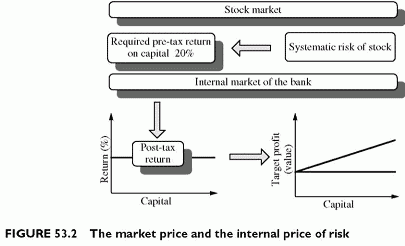THE INTERNAL PRICE OF RISK AND THE PRICE OF RISK IN THE CAPITAL MARKETS
Category: Risk Management in Banking
According to the CAPM, the required return on capital results from the market price of systematic risk of the stock. The APT model would provide similar benchmarks. Hence, it is possible to define a cost of equity depending on the risk of the banks stock required return in the equity market. This is the theoretical hurdle rate for RaRoC and SVA. Once this rate is set, for instance at 20%, the internal price of risk follows. It is the required profit by unit of capital, or 20% of capital. This relationship is summarized in Figure 53.2.
Different businesses within the same bank require different returns if they have different systematic risks. Making such a differentiation explicit is feasible, legitimate and relevant for those institutions involved in very different businesses. Another issue is subtler. It relates to the potential gap between the internal price of risk derived from economic capital and the market price of credit or market risk.
The internal price of risk is the additional profit per unit of capital, or the additional profit per unit of loss volatility. This is not the market price of equity risk measured by the CAPM or the APT models. These two prices are different. The two notions are distinct. Such discrepancies can lead to conflicting signals for those who make market transactions.
The above example of narrow spreads due to competition illustrates the issue. The issue extends to all market-priced risks. There is no reason why the credit spreads of bonds should match the internally defined credit risk-based price, other than by coincidence. A risky bond has a value of 1000 and the credit spread that prevails in the market for its risk class is 0.5%, or 5. The required capital, economic or regulatory, is 4% x 1000 = 40. The capital-based return should be 20% x 40 = 8, or 0.8% of the bond value. It is different from the 0.5% market spread. Discrepancies can appear with both economic capital and regulatory capital. A portfolio manager trying to meet the internally required return would not do so given the external market conditions.
Discrepancies are not surprising. Economic capital measures the overall volatility of losses post-diversification, whereas bond credit spreads relate to default probabilities, recovery rates and risk aversion. Similarly, the required return on equity of a bank results from the systematic risk of its stock. The economic capital depends on the portfolio risk, and includes both specific and general risk. Nothing ensures a parity between the risk premia required by the banks shareholders and by the investors in bonds of issuers to whom the bank lends.
It is possible to reconcile the two approaches by adjusting the economic capital to the value that makes 5 equal to the required profit on internal risk. This would be achieved with an economic capital such that 5 = 20% x capital, or a capital of 25. This is the implied capital in market rates. A mathematical solution for reconciling internal and external prices would be to adjust the confidence level so that the economic capital matches the implied capital in market spreads. This is more a theoretical consideration than a helpful business conclusion.
Making a clear distinction between the two prices of risk helps. If not, the management could assign unrealistic target profitability to those who operate in the market. In addition, it is important to consider other revenue sources than pure spreads. Finally, it makes sense to arbitrage the market valuation of credit risk when the discrepancy is favourable to the bank.
Risk-adjusted Performance Implementation
The purpose of this chapter is to present practical calculations when implementing risk contributions and risk-adjusted profitability measures. It details calculations of absolute versus marginal risk contributions, and of risk-based profitability, with ex post performances (Risk-Adjusted Performance Measurement, RAPM) versus ex ante Risk-Based Pricing (RBP). The calculations illustrate the general properties of the risk contributions and of risk-adjusted profitability, as introduced previously.
Economic income statements serve for reporting risk-adjusted measures of performance. Risk-based pricing piles up all costs, including the necessary mark-ups for absorbing risk (EL and capital compensation). Assuming that prices are in line with both risk and the target compensation of risks, ex post Risk-adjusted Return on Capital (RaRoC) and Shareholders Value Added (SVA) measures differ from the ex ante measures because the absolute risk contribution replaces the marginal risk contribution once a facility is in the portfolio. Moreover, these measures drift with time, as risk does spontaneously, when time passes.
The examples demonstrate that RBP using marginal contributions does ensure that the ex post RAPM of the portfolio using absolute contributions is effectively in line with the target return.
The first section details the calculations of RaRoC and SVA and presents economic income statements, or risk-adjusted performance reporting on an ex post basis. The second section shows how to derive the target price from target return and risk, and contrasts ex ante versus ex post views of risk-adjusted measures. The third section compares RaRoC and SVA based on absolute and marginal risk contributions. It also shows through examples that RBP on marginal contributions guarantees the RAPM target under portfolio expansion.

